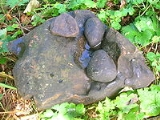
Bullaun
Encyclopedia

Local folklore often attaches religious or magical significance to bullaun stones, such as the belief that the rainwater collecting in a stone's hollow has healing properties. Ritual use of some bullaun stones continued well into the Christian period and many are found in association with early churches, such as the 'Deer' Stone at Glendalough
Glendalough
Glendalough or Glendaloch is a glacial valley in County Wicklow, Ireland. It is renowned for its Early Medieval monastic settlement founded in the 6th century by St Kevin, a hermit priest, and partly destroyed in 1398 by English troops....
, County Wicklow
County Wicklow
County Wicklow is a county in Ireland. It is part of the Mid-East Region and is also located in the province of Leinster. It is named after the town of Wicklow, which derives from the Old Norse name Víkingalág or Wykynlo. Wicklow County Council is the local authority for the county...
. The example at St Brigit's Stone County Cavan
County Cavan
County Cavan is a county in Ireland. It is part of the Border Region and is also located in the province of Ulster. It is named after the town of Cavan. Cavan County Council is the local authority for the county...
still has its 'cure' or 'curse' stones. These would be used to by a visitor turning them whilst praying for or cursing somebody.
St. Aid or Áed mac Bricc
Áed mac Bricc
Áed mac Bricc was an Irish bishop and saint. Áed's principal church was at Rahugh in modern County Westmeath. He was regarded as a patron saint of the Uí Néill and was said to be a descendant of Fiachu mac Néill...
was Bishop of Killare in 6th-century. At Saint Aid's birth his head had hit a stone, leaving a hole in which collected rainwater that cured all ailments, thus identifying it with the Irish tradition of Bullaun stones.
Bullauns are not unique to Ireland, being also found on the Swedish
Sweden
Sweden , officially the Kingdom of Sweden , is a Nordic country on the Scandinavian Peninsula in Northern Europe. Sweden borders with Norway and Finland and is connected to Denmark by a bridge-tunnel across the Öresund....
island of Gotland
Gotland
Gotland is a county, province, municipality and diocese of Sweden; it is Sweden's largest island and the largest island in the Baltic Sea. At 3,140 square kilometers in area, the region makes up less than one percent of Sweden's total land area...
, and in Lithuania and France. Possibly enlarged from already-existing solution-pits caused by rain, bullauns are, of course, reminiscent of the cup-marked stones
Cup and ring mark
Cup and ring marks or cup marks are a form of prehistoric art found mainly in Atlantic Europe and Mediterranean Europe although similar forms are also found throughout the world including Mexico, Brazil, Greece, and India, where...
which occur all over Atlantic Europe, and their significance (if not their precise use) must date from Neolithic times.

